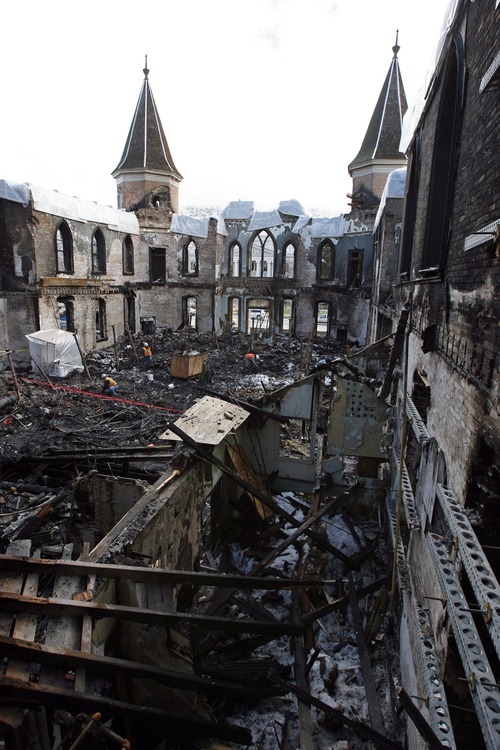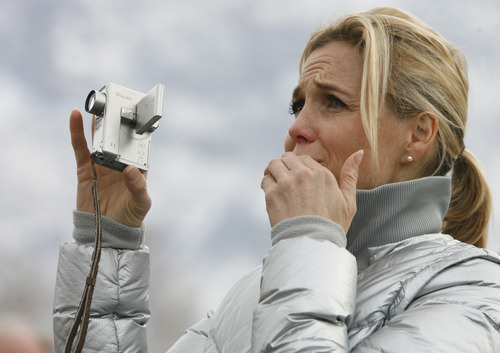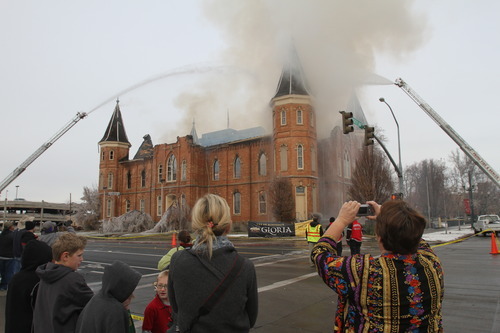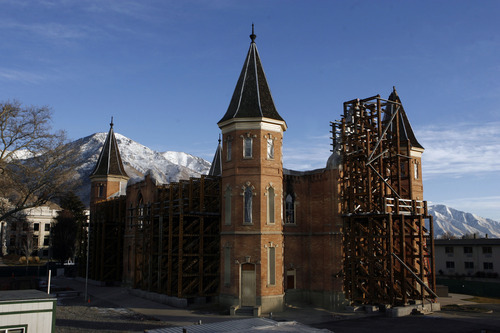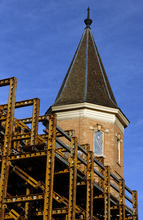This is an archived article that was published on sltrib.com in 2011, and information in the article may be outdated. It is provided only for personal research purposes and may not be reprinted.
Provo • A year to the day after a fire destroyed the Provo Tabernacle, the LDS Church's plan to restore the historic building and convert it into a Mormon temple is expected to bring more to the city than spiritual blessings for devout Latter-day Saints.
Civic and business leaders figure it also will bring people — and their wallets — downtown, further energizing the heart of Provo.
"What it has done is legitimize the efforts of a lot of people to bring prosperity to downtown," said Richard Gregory, owner of the Provo Town Square commercial center across the street from the tabernacle.
But the anticipated gains will come with a loss: When the temple is dedicated, the building — for decades a home to concerts, commencements and other community events — will be open only to faithful Mormons.
"It is good that they are saving it, but it is sad that it will not be a community building anymore," said Kena Jo Matthews, chairwoman of the Utah Valley Ministerial Association.
That sadness was greatest the morning of Dec. 17, 2010, when residents flocked downtown in subfreezing temperatures to watch firefighters battle the blaze that consumed the 128-year-old building's interior.
The fire started after a technician left a powerful ceiling light sitting next to a wooden box in the attic. The light had been removed to make way for a performance of Lex de Azevedo's "Gloria."
The hot light ignited the wood. Then, an off-duty Provo police officer mistook a fire alarm for a malfunctioning burglar alarm and shut it off.
After the blaze, residents wondered whether the tabernacle would be razed or rebuilt.
Provo Mayor John Curtis asked LDS officials at the time how he could assuage those concerns.
"The church [officials] said, 'You can tell them two things: We understand the significance of this building and its importance culturally to Provo. We pretty much feel the same way. And we will do the right thing.' "
Although turning the building into a temple was more of a "what-if" scenario, Curtis said it was clear church leaders were leaning heavily toward preserving the edifice. A massive framework of steel girders, set in heavy concrete footings, braced the walls while church employees sifted through historical records about the tabernacle.
Curtis said the promise to "do the right thing" was fulfilled in October, when LDS Church President Thomas S. Monson announced that the tabernacle would be restored to its original appearance — including a center spire that was dismantled in 1917 because it was too heavy for the roof — and transformed into a temple.
Not only does that plan preserve the building, Curtis said, but it also gives downtown Provo a much-needed boost.
"Property values in our neighborhoods that we have worked so hard to increase over the years increased almost overnight," Curtis said. "We know people like to live close to temples, and people who live close to temples take care of their property."
Gary McGinn, Provo's community development director, recalled a meeting he had with church representatives to discuss the proposed temple. McGinn had joked that the church was throwing down the gauntlet for improving downtown.
"And [the church representative] looked at me and said, 'Yes, we are. We are raising the bar, and you're going to have to work hard to keep up.' "
It's not like city planners had been sitting on their hands. Provo has been working on various ways to attract businesses and heard recommendations from a marketing group on how to get Brigham Young University students to shop and eat downtown.
Other projects, such as Nu Skin Enterprises' expansion and the Utah County Convention Center — set to open in the spring — are expected to bring back crowds that disappeared when University Mall was built in Orem in the 1970s.
Gregory, of Provo Town Square, views the planned temple as a vital step forward in the revitalization. Previously, he said, some entrepreneurs had looked at efforts to kick-start the area with a wary eye.
Afterward, he saw business rentals increase. And he expects another of his ventures to benefit as well. Before the announcement, Gregory had converted the former Los Hermanos site on the corner of University Avenue and Center Street into a wedding reception center. Since then, he's had friends jokingly ask if he had inside information in order to capitalize on the weddings that will take place in the new temple.
"This temple was like the final stamp of approval," Gregory said, "that this downtown is valuable, it is the core of a larger community."
Kathryn Allen, executive director of Provo's Downtown Business Alliance, is counting on temple-goers doing more than worshiping downtown.
"I hope people won't park, go in [the temple], go out and go home," Allen said. "I hope they say, 'Let's go out to lunch' and go to one of the restaurants here."
Salvador Lara, who owns Joe Vera's Mexican Restaurant on Center Street, is expecting them to do just that.
"Local business," Lara said, "will be much better with that temple."
Still, the planned temple is bittersweet for many residents. Although delighted to see the historic building preserved, they mourn the tabernacle's loss as a community gathering place.
Besides hosting a range of Mormon meetings — including the faith's General Conference in the 1880s — the tabernacle has staged concerts, funerals, high school graduations and other public events. One Christmas Eve, Catholics conducted Mass within its walls.
Matthews notes her ministerial association used the tabernacle for its annual National Day of Prayer program.
There are other public venues in downtown — the coming convention center and the Covey Center for the Arts — but none has the tabernacle's ambience.
"I like historic buildings," Matthews said.
She and thousands of others will be able to tour the restored building prior to its dedication as a temple.
"I wouldn't be surprised to see a lot of people wanting to go in," said the Rev. Dean Jackson, pastor of Provo's Rock Canyon Assembly of God Church.
After the dedication, the building will be closed to all but temple-worthy Mormons. The building's grounds will be open, and its restored exterior will be visible to all.
Twitter: @donaldwmeyers
facebook.com/donaldwmeyers —
Street may close, too
Provo recently conducted a traffic study looking at the possibility of closing 100 South between University Avenue and Freedom Boulevard, a move that would allow the LDS Church to connect the tabernacle property with the land it bought on the block to the south.
City Engineer David Graves said the study — which found improved traffic flow on University Avenue with the road closure — was commissioned at the Municipal Council's request. He said the church has not indicated if it wants to close the street.
LDS Church spokesman Scott Trotter said the church has had discussions about transportation issues, but is still in the process of designing the new temple and weighing options.
- Donald W. Meyers



